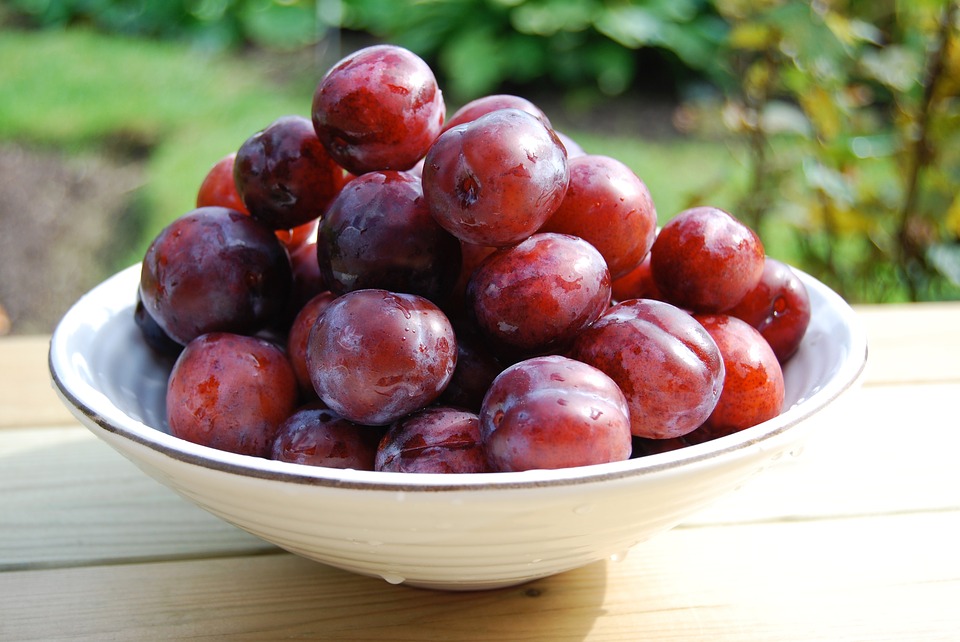
Combining plums and apricots
Pluots are a plum and apricot hybrid, capturing the looks and tastes of both fruits together. They have a smooth, red-purple skin and golden flesh inside and their texture is a little like a peach.
The name ‘pluot’ is clearly a cross between the plum and the apricot, but did you know a similar plum and apricot hybrid fruit had already been invented, called by a different name?
The plumcot and the pluot
The plum apricot hybrid fruit was originally invented in the late 19th century and called a plumcot. This early fruit was made of equal parts of plum and apricot. In the 1980s, the new pluot arrived with a different proportion of the two fruits. The pluot is more plum than apricot with three-quarters of the fruit being plum and only one quarter apricot.
Pluots can be eaten as a whole fruit and are ideal for breakfast or as a snack. They can also be used in cooking and to make jams and puddings. The reddish fruit is perfect in crumbles and you can combine it with apple for a rich, autumnal flavour. Pluots also work in savoury dishes and can be used in salads or grilled, baked or sauteed with meat and fish.
Strasberries and pineberries
There are many other hybrid fruits that have graced our menus and fruit bowls in recent years, including the strasberry and the pineberry. The strasberry is a hybrid of the strawberry and raspberry, while the pineberry is actually a type of strawberry that has a white coloration and tastes like pineapple. Delicious!
Strasberries have been named quite cleverly, using the starting ‘st’ letters of the word ‘strawberry’ and most of the word ‘raspberry’. This creates a word that slips off the tongue easily (i.e. if a word ‘slips off the tongue’, it means the word is easy to say). Pineberries are also linguistically comfortable, combining the ‘pine’ of a pineapple – the flavour of the hybrid fruit – and the ‘berries’ from a strawberry and all berry fruits.
Many fruits we know today are actually created from a combination of two or other more fruits. You might be surprised to learn that oranges and lemons were created hundreds of years ago by combining other fruits, although they are now known as fully-fledged fruits in their own right.
Surprising hybrid fruits
Some of the popular fruits we all eat today began their life as two distinct fruits. Combining the trees or bushes of the fruit with another species, new fruits were created. Lemons, oranges, grapefruit and loganberries are all the result of a mixing of two origin fruits:
Lemons
The lemon originates from the Far East and was actually the result of a cross between a bitter orange and a citron.
This yellow-orange citrus favourite might be too bitter to eat as a hand fruit, but it lends itself to cooking and is perfect as an accompaniment or flavouring to many sweet and savoury dishes to give a zesty kick.
Oranges
Oranges are some of the most famous and well-loved fruits in the world, but this distinctive fruit is originally thought to have derived from a cross between a pomelo and a tangerine.
Oranges are now eaten far more regularly than either of these two origin fruits, while their juice is the most popular fruit juice drink in the world.
Grapefruit
Another hybrid fruit is the grapefruit. Grapefruit was created in the 1700s when Indonesian pomelo fruit hybridised with the indigenous oranges of Barbados, after pomelo trees were introduced to the island.
Refreshingly tart to the taste buds, this medium-sized yellow fruit has become one of the most popular breakfast fruits.
Loganberries
Loganberries are not as famous as the other fruits in this list, but many people enjoy their gentle flavour.
This purple-red fruit was named after James Harvey Logan, a Californian judge and horticulturalist who invented the fruit in 1881 after crossing a type of North American blackberry with a Red Antwerp raspberry.
- Check our out fruit and veg idioms for a fun and useful EFL lesson!
Share your thoughts on hybrid fruits and food names
Have you ever tried a pluot, plumcot, strasberry or pineberry? What did you think?
Do you know any historical facts about hybrid foods?
What do you think are the strangest fruit names?
Do you have any interesting hybrid foods in your native country? What are they called?
We’d love to hear your opinions and thoughts – leave a comment in the box below!
